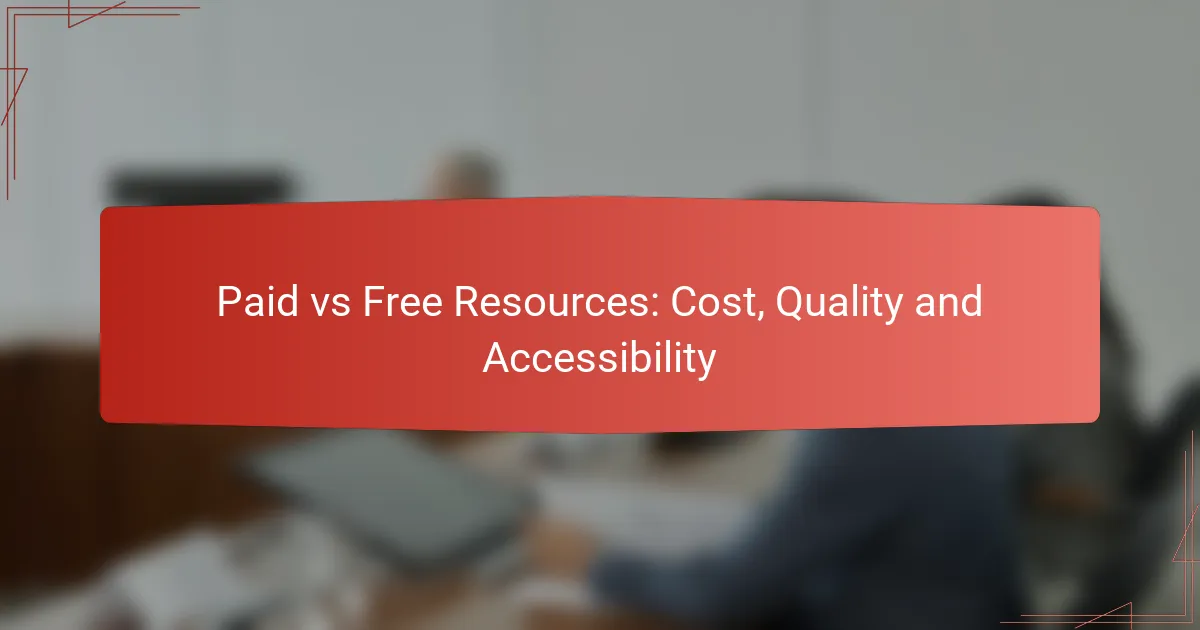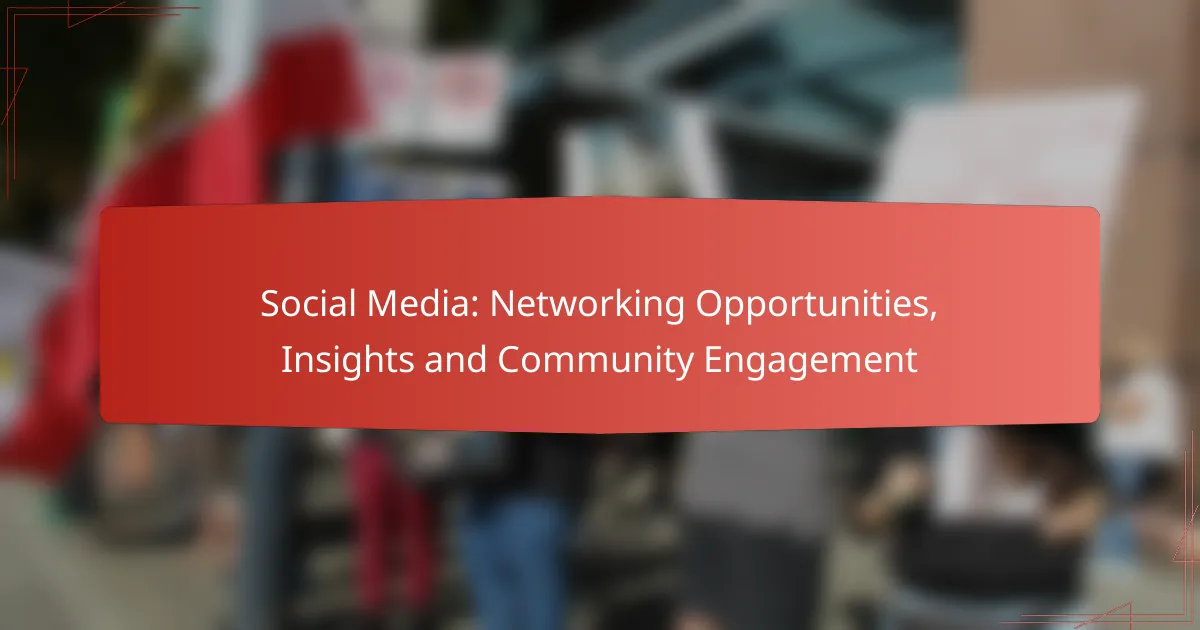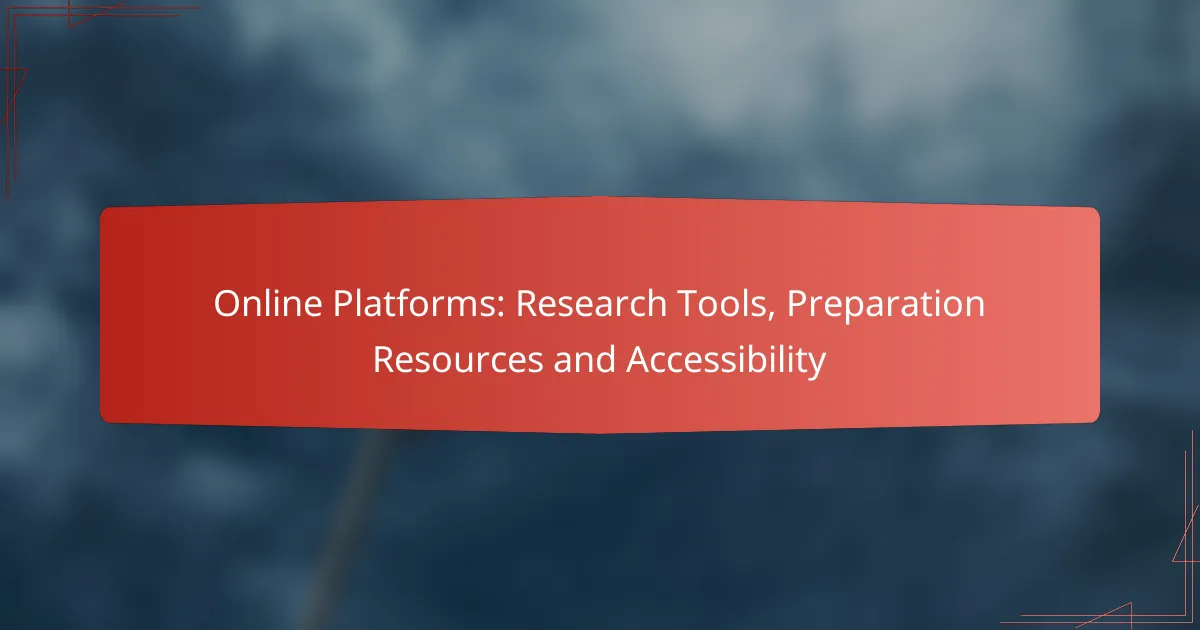When choosing between paid and free resources, it’s essential to consider factors such as cost, quality, and accessibility. Paid resources generally provide higher quality content and dedicated support, making them valuable for professional and academic pursuits. However, the financial burden can limit access for some users, while free resources may offer varying levels of quality that require careful evaluation for reliability.
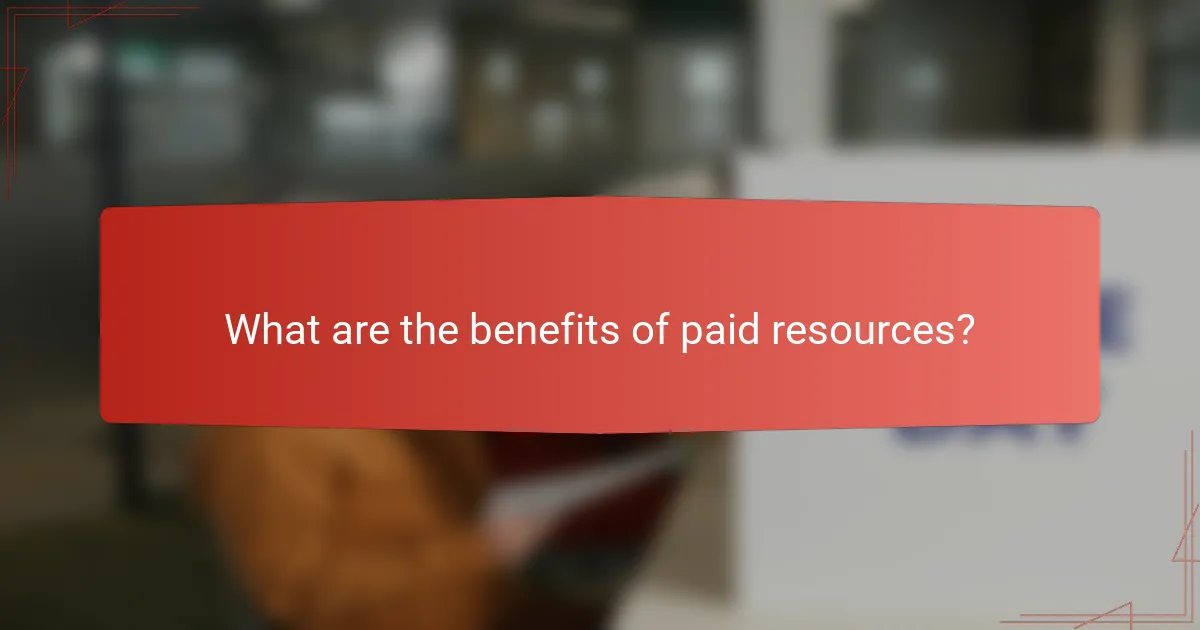
What are the benefits of paid resources?
Paid resources typically offer superior quality, exclusive features, and dedicated support compared to free options. Investing in these resources can enhance your experience and outcomes, especially in professional or academic contexts.
Higher quality content
Paid resources often provide higher quality content due to professional curation and expert contributions. This can include well-researched articles, comprehensive guides, and up-to-date information that is less likely to be found in free resources.
For example, academic journals and industry reports that require subscriptions frequently offer peer-reviewed studies and data that are crucial for in-depth analysis. This level of quality can be essential for making informed decisions in business or research.
Exclusive access to premium features
Many paid resources come with premium features that enhance usability and functionality. These may include advanced search options, ad-free experiences, or access to specialized tools that are not available in free versions.
For instance, a paid software tool might offer analytics features that allow users to track performance metrics, while free versions may only provide basic functionalities. This can significantly improve productivity and effectiveness.
Dedicated customer support
Paid resources usually include dedicated customer support, which can be a major advantage when issues arise. This support often comes in the form of live chat, email assistance, or phone support, ensuring that users can quickly resolve problems.
In contrast, free resources may offer limited or no customer support, leaving users to troubleshoot on their own. Having access to reliable support can save time and reduce frustration, especially when using complex tools or platforms.

What are the drawbacks of paid resources?
Paid resources often come with significant drawbacks, primarily related to cost and accessibility. Users may find themselves limited by financial constraints, which can hinder their ability to access valuable information or tools.
Cost barriers for users
The cost of paid resources can be a substantial barrier for many individuals. Prices can range from modest monthly subscriptions to high one-time fees, making it difficult for some users to justify the expense. For example, online courses may charge anywhere from $50 to several hundred dollars, depending on the content and provider.
When considering paid resources, users should weigh the potential benefits against the costs. It may be helpful to look for free trials or tiered pricing options that allow for initial exploration without a full financial commitment.
Limited accessibility for low-income audiences
Paid resources often exclude low-income audiences who cannot afford the fees, leading to a digital divide. This lack of access can prevent individuals from gaining essential skills or knowledge that could improve their economic situation. For instance, a subscription to a professional development platform might be out of reach for someone earning minimum wage.
To address this issue, some organizations offer scholarships or sliding scale fees for low-income users. Exploring community resources, such as public libraries or local non-profits, can also provide access to valuable information without the financial burden.
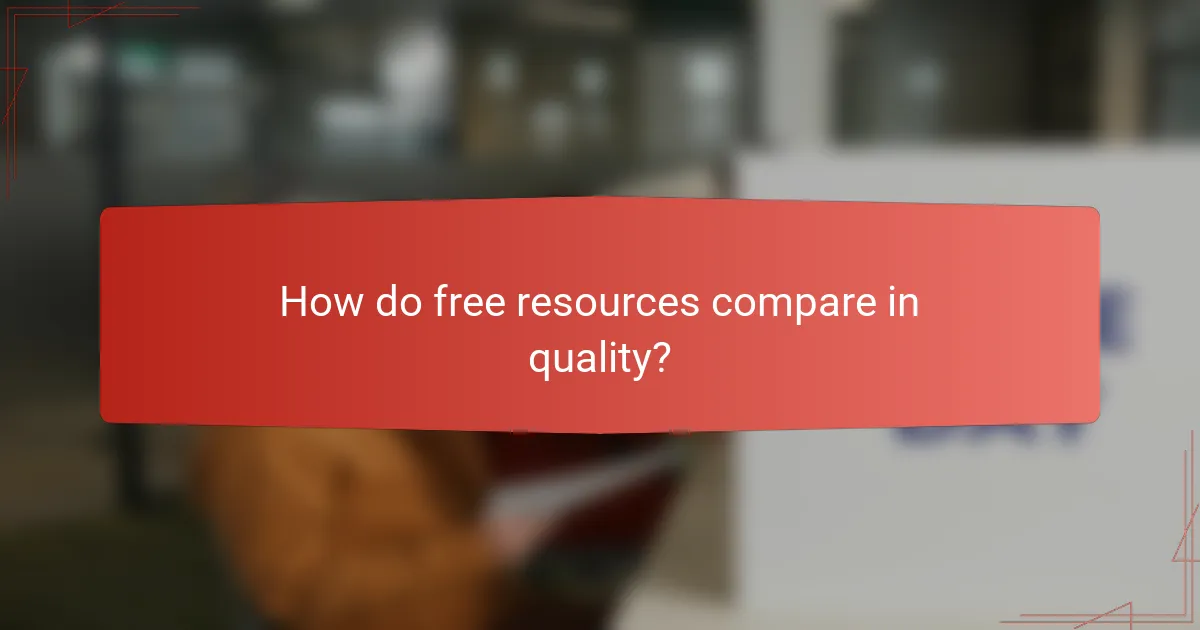
How do free resources compare in quality?
Free resources often vary significantly in quality, with some providing excellent information while others may lack depth or accuracy. Users should assess the credibility and reliability of these resources before relying on them for important decisions.
Variable content quality
The quality of free resources can fluctuate widely based on the source and the expertise of the contributors. While some platforms may offer well-researched articles or tutorials, others might present outdated or misleading information. It’s essential to critically evaluate the content and consider the author’s qualifications.
For instance, a free online course from a reputable university may provide high-quality material, whereas a blog post from an unknown author might not meet the same standards. Users should look for indicators of quality, such as citations, references, and user reviews.
Community-driven contributions
Many free resources rely on community-driven contributions, which can enhance the diversity of perspectives but also introduce inconsistencies. Platforms like Wikipedia or open-source forums allow users to edit and add content, leading to a rich repository of information. However, this collaborative approach can result in varying levels of accuracy and expertise.
When using community-driven resources, it’s beneficial to check the edit history and contributor credentials. Engaging with user comments and discussions can also provide insights into the reliability of the information presented. Always cross-reference with established sources to ensure accuracy and comprehensiveness.
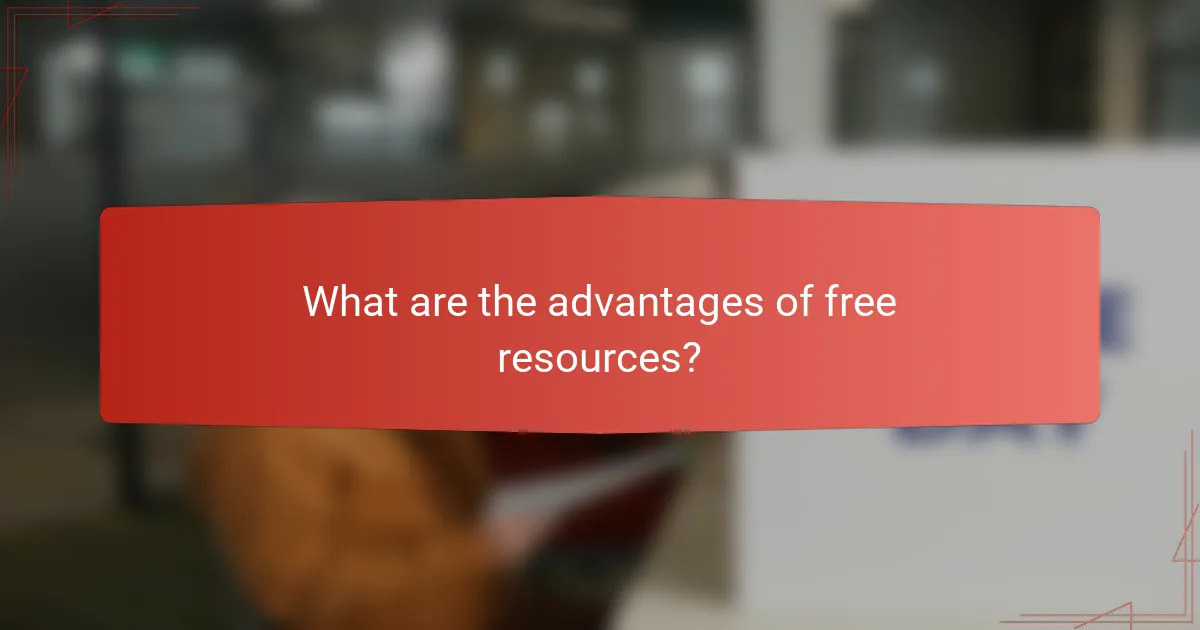
What are the advantages of free resources?
Free resources offer significant benefits, including no financial commitment and broader access for various audiences. They enable individuals to learn and develop skills without the burden of costs, making education and information more inclusive.
No financial commitment
One of the primary advantages of free resources is the absence of any financial obligation. This allows users to explore a wide range of materials without worrying about subscription fees or purchase costs.
For example, many online platforms provide free courses, e-books, and tutorials that can be accessed at no charge. This accessibility encourages users to try new subjects and skills without the risk of wasting money.
Wider accessibility for diverse audiences
Free resources cater to a diverse audience by removing barriers related to income and location. Individuals from varying backgrounds can access the same quality of information, which promotes equal opportunities for learning.
Moreover, many free resources are available in multiple languages and formats, enhancing their usability for non-native speakers and those with different learning preferences. For instance, platforms like Khan Academy and Coursera offer free courses that can be accessed globally, making education more equitable.
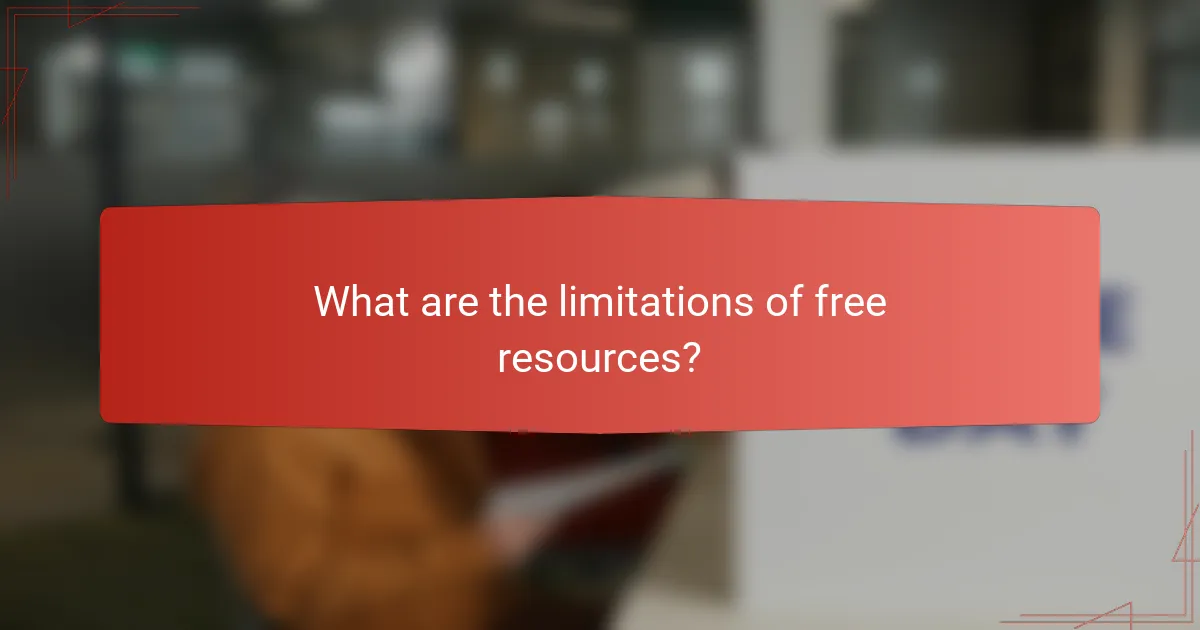
What are the limitations of free resources?
Free resources often come with significant limitations that can affect their reliability and effectiveness. Users may encounter issues such as outdated information, lack of comprehensive support, and variable quality, which can hinder their learning or project outcomes.
Potential for outdated information
Free resources frequently suffer from outdated information, as they may not be regularly updated. This can lead to users relying on obsolete data or practices that are no longer relevant or effective.
For example, in fields like technology or medicine, guidelines can change rapidly. Relying on free resources without checking for the latest updates can result in using ineffective or even harmful practices.
Lack of comprehensive support
Many free resources do not offer comprehensive support, which can leave users without guidance when they encounter difficulties. Unlike paid options that often include customer service or community forums, free resources may lack avenues for assistance.
This absence of support can be particularly challenging for beginners who may need more help understanding complex topics. Users should consider supplementing free resources with paid options or community groups to ensure they have access to the necessary support.

How to choose between paid and free resources?
Choosing between paid and free resources involves evaluating your budget, content needs, and long-term goals. Each option has its advantages and drawbacks, so understanding these factors will help you make an informed decision.
Assessing personal budget
Your budget is a crucial factor in deciding between paid and free resources. Free resources can be appealing, but they may lack depth or quality, while paid options often provide more comprehensive content and support. Consider how much you can realistically allocate for learning or resource acquisition, whether it’s a few dollars per month or a larger annual investment.
When assessing your budget, think about the potential return on investment. For example, spending $50 on a specialized course might yield better results than relying on free materials that may not meet your needs.
Evaluating content needs
Identifying your content needs is essential in the decision-making process. If you require in-depth knowledge or specialized skills, paid resources often offer structured learning paths and expert insights that free options may lack. Conversely, if your needs are basic or exploratory, free resources can suffice.
Make a list of specific topics or skills you want to learn. Compare the quality and comprehensiveness of available free resources against paid options to determine which aligns best with your requirements.
Considering long-term goals
Your long-term goals should influence your choice between paid and free resources. If you aim for career advancement or a significant skill upgrade, investing in high-quality paid resources may be worthwhile. These often provide certifications or credentials that can enhance your resume.
On the other hand, if your goals are more casual or short-term, free resources may be adequate. Assess how each option aligns with your future aspirations and whether the investment will pay off in the long run.
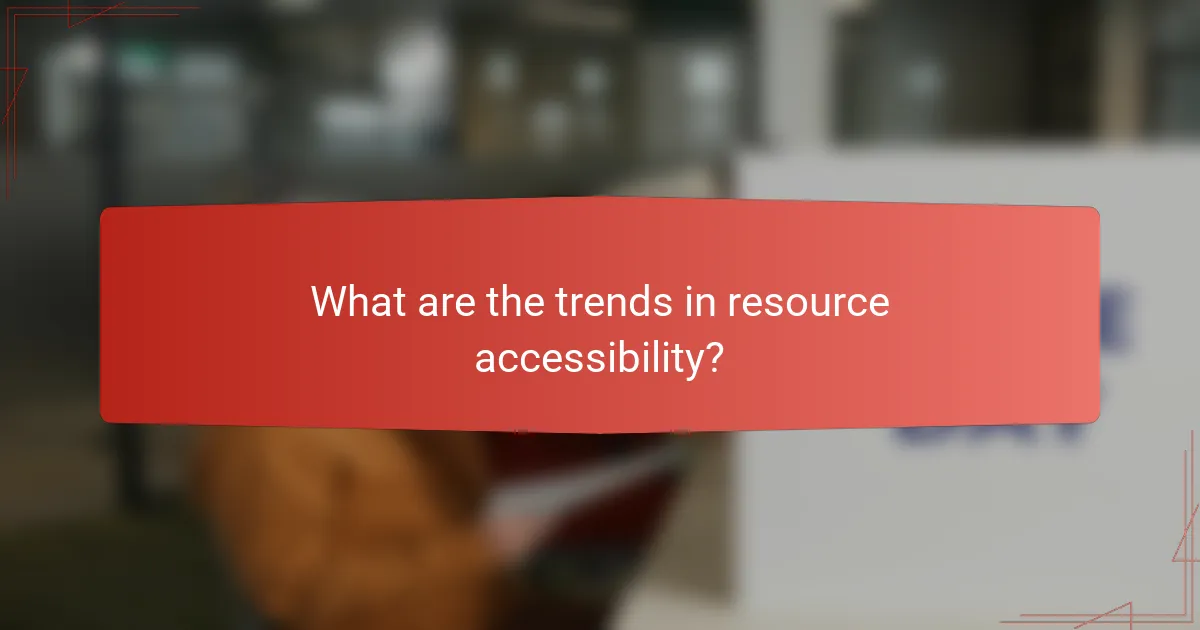
What are the trends in resource accessibility?
Resource accessibility is increasingly influenced by the balance between paid and free options. While free resources are widely available, they often come with limitations in quality and support, whereas paid resources typically offer enhanced features and reliability.
Cost Comparison
The cost of resources can vary significantly between free and paid options. Free resources are, as expected, available at no charge, but they may lack comprehensive features or up-to-date information. Paid resources, on the other hand, often range from a few dollars to several hundred dollars per month, depending on the depth of content and support provided.
When considering cost, it’s essential to evaluate the return on investment. For instance, investing in a paid course might save time and provide better outcomes compared to piecing together information from various free sources.
Quality of Resources
Quality is a critical factor when assessing resource accessibility. Free resources can be hit or miss, with some offering valuable insights while others may be outdated or inaccurate. Paid resources generally maintain higher quality standards, often backed by expert reviews and regular updates.
For example, a free online tutorial might provide basic information, but a paid course often includes structured learning paths, expert feedback, and additional materials that enhance understanding and retention.
Accessibility and User Experience
Accessibility in resources refers to how easily users can access and utilize them. Free resources may have limited accessibility due to ads, poor navigation, or lack of customer support. In contrast, paid resources typically prioritize user experience, offering intuitive interfaces and dedicated support.
Consider the accessibility of platforms when choosing resources. For instance, a subscription-based service might provide offline access and mobile compatibility, making it easier to learn on the go compared to a free website that requires constant internet access.
